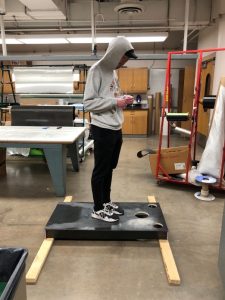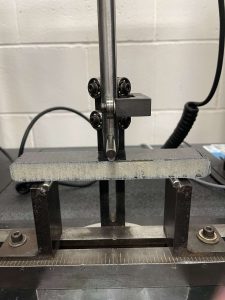Many different qualification tests were performed by the Carbon Cornhole team in order to ensure that a quality and visually appealing product was being produced.
The following tests were performed on the product and the data was recorded.
- Visual Inspection
- Surface Roughness
- Voids
- Foreign Material
- Dimensional Inspection
- Impact Resistance
- Flexural Strength
- UV Resistance
- Water Resistance
- Weight
Pictures and data from each test are shown below:
Visual Inspection:

Each aspect of the visual inspection passed according to the criteria determined by the manufacturing team. The surface roughness was taken in 5 different locations on the top of the board and averaged out to give a representative value. The voids and foreign material were inspected by the team members.
Dimensional Inspection:
The dimensions were crosschecked for each piece of the assembly with the relevant drawings and no parts had dimensions which were outside the dimensions and their tolerances.
Impact Resistance:
Impact resistance was tested by dropping a 1 lb weighted bean bag from a height of 16 feet and then inspecting the surfaces and adjoined areas for any visible damage.

An image of the Carbon Cornhole team testing the impact resistance properties of the board.
![]()
After testing, there was no evidence of visible damage.
Flexural Strength:
To test the flexural strength of the product, the team determined that they wanted the ability for a person of 150 lb to be able to step on the center of the board without failure. To test this, a team member specimen who weighed more than 150 lb was placed in the center of the board while it was simply supported on the front and the back.

A member of the team standing on the center of the board to test the flexural properties.
![]()
After testing, no failures were present throughout the board assembly.
UV resistance:
UV resistance was tested according to ASTM G154 using a QUV Accelerated Weathering Tester on cycle #2. Three specimen were subjected to extended UV exposure and compared to a control group to determine whether the board could retain properties if it were to be left out in the elements for an extended amount of time. The control and UV samples were tested according to ASTM D790 using a 3-point bend apparatus to find the max load of each sample.

A UV exposed sample in the 3-point bend fixture during testing.

Water Resistance:
Water resistance was tested to determine whether the product could be exposed to water for an extended period of time. The samples were submerged in water for 24 hours and then tested according to ASTM D790 using a 3-point bend apparatus to find the max load of each sample. These samples were compared to that of a control group to determine whether they could retain strength after exposure.

A water exposed sample in the 3-point bend fixture during testing.

Weight:
The team wanted to create a board that was less than 20 lb to demonstrate the lightweight nature of composite materials.
![]()
Overall, the assembly passed all subsequent tests required.